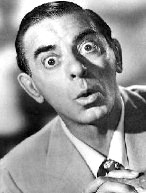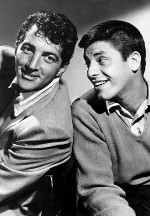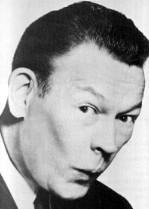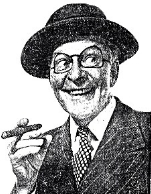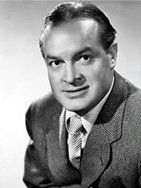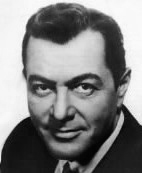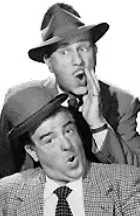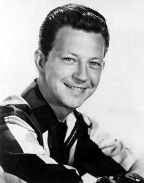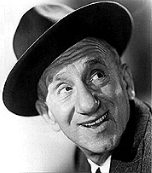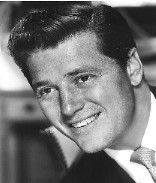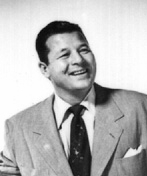| The
Hosts |
| | Eddie
Cantor
Season
1 - 12 Episodes
Season 2 - 12 Episodes
Season 3 - 7 Episodes
Season
4 - 7 Episodes
Known
as "Banjo Eyes," Eddie Cantor was one of the biggest stars of vaudeville,
Broadway, movies, and radio. Cantor hosted more episodes of The Colgate Comedy
Hour than anyone else, including the very first one. |
| | Dean
Martin & Jerry Lewis
Season
1 - 8 Episodes
Season 2 - 5 Episodes
Season 3 - 5 Episodes
Season
4 - 4 Episodes
Season 5 - 4 Episodes
Season 6 - 2 Episodes
Martin and Lewis
were an up-and-coming comedy team, with a popular radio show and two My Friend
Irma movies to their credit when they began their Comedy Hour stint.
This early TV work was closer to their nightclub and stage show act, and many
fans consider it funnier and more "authentic" than their movies. |
| | Fred
Allen
Season 1 - 4 Episodes
Fred
Allen had been one of radio's biggest stars but didn't fare nearly as well on
television. His verbal wit wasn't well suited to the new video medium, where the
seltzer bottle and pie in the face were the order of the day. A charter member
of The Colgate Comedy Hour, Allen only hosted four episodes but showed
up as a guest in a few subsequent ones. |
| | Bobby
Clark
Season 1 - 4 Episodes
Like
Eddie Cantor, Bobby Clark was a former vaudevillian who had gone on to star on
Broadway and in films. Clark had been half of the team of Clark and McCullough
before his partner Paul McCullough committed suicide with a barber's razor in
1936. Clark's eyeglasses were painted on. |
| |
Bob
Hope
Season 1 - 3 Episodes
Season 2 - 3 Episodes
Season 3 - 10
Episodes
Season 5 - 1 Episode
Though
Bob Hope was one
of the earliest movie stars to embrace television, his appearances on that medium
generally consisted of occasional specials. His Comedy Hour performances
fit that pattern, although in the third season, they were more regular. |
| |
Tony Martin
Season 1 -
2 Episodes
Season 2 - 1 Episode
A
gifted singer, Tony Martin was also a talented saxophonist and comedian. Though
he only hosted three Comedy Hour episodes, Martin guest starred in several
others. | |
| Abbott
& Costello
Season 1 - 2 Episodes
Season 2 - 6 Episodes
Season
3 - 6 Episodes
Season 4 - 4 Episodes
Season 5 - 1 Episode
Abbott & Costello
were the most successful comedy team of the 1940s, with some of the highest grossing
films of the decade. Following a popular radio show, they moved into television
with a filmed series that ran concurrently with their Colgate Comedy Hour
appearances. | |
| Donald
O'Connor
Season 2 - 7
Episodes
Season 3 - 5 Episodes
Season 4 - 4 Episodes
Donald O'Connor
was a qaudruple threat who could act, sing, dance, and do comedy. As a particularly
acrobatic dancer, he was a natural co-star to Gene Kelly in Singin' in the
Rain. He lasted three years on The Comedy Hour and was one of the hosts
most closely identified with the show. |
| | Jimmy
Durante
Season 4 - 8
Episodes
One
of America's most beloved entertainers, Jimmy Durante spent a brief but memorable
season on The Colgate Comedy Hour. His act was similar to that seen on
his other radio and TV shows, including the trademark, "Good night, Mrs.
Calabash, wherever you are." |
| | Gordon
MacRae
Season 5 - 12 Episodes
Unlike
most of the other Colgate hosts, Gordon MacRae was a singer rather than a comedian
and was billed as "your singing host." He went on to greater fame in
the movies Oklahoma! and Carousel. |
| | Jack
Carson
Season 2 - 1 Episode
Season 6 - 3 Episodes
A
verstatile character actor, equally comfortable in both comedy and drama, Jack
Carson was a familiar face to moviegoers. He made a series of films co-starring
Dennis Morgan and was popular on radio before moving into television. |
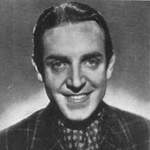 |
Robert
Paige
Season 6 - 4 Episodes
Robert
Paige had the dubious distinction of being the very last host of The Colgate
Comedy Hour. Though not as well-known as some of the show's other emcees, he
enjoyed a prolific film career (during which he was the only
man allowed to sing alongside Deanna Durbin). In the 1950s, Paige found a niche in television,
as both a dramatic actor and frequent host. He later became a newscaster in Los Angeles. |
|
Broadcast
History
Sundays, 8:00 - 9:00 pm, NBC-TV
The
Colgate Comedy Hour (9/10/1950 - 6/5/1955)
The Comedy Hour (Frigidaire-sponsored
episodes, 10/1/1950 - 5/13/1951)
The Colgate Summer Comedy Hour (6/6/1954
- 9/5/1954)
The Colgate Variety Hour (6/12/1955 - 12/25/1955)
The
NBC Comedy Hour (1/8/1956 - 6/10/1956) If
you're under the age of 50, chances are you've never heard of The Colgate Comedy
Hour. But way back at the dawn of the TV age, this show was one of the most
popular on the air, eclipsing even the venerated Ed Sullivan and Your Show
of Shows. In fact, The Colgate Comedy Hour occupied the same Sunday
night at 8:00 time slot as the Sullivan program (then known as Toast of the
Town) and on a weekly basis dealt it a sound thrashing in the ratings race.
In 1950, NBC teamed with the Colgate-Palmolive-Peet Company to create a TV show
that's only dimly remembered today but deserving of more recognition. The secret
of the show's success wasn't the format - that was pretty conventional. As the
name implied, it was heavy on the comedy, with a bit of singing and dancing thrown
in for good measure. But the combination of a sizable budget (for its time), funny
and entertaining material, and a roster of big name stars ensured its popularity. The
stars, mostly veterans of vaudeville, Broadway, radio, or movies, took turns hosting,
usually in four or five week cycles. In the first few seasons, those most frequently
seen were Eddie Cantor, Dean Martin and Jerry Lewis, Bob Hope, Abbott & Costello,
Donald O'Connor, and Jimmy Durante. Martin and Lewis were particular standouts,
with many fans considering their Colgate work the best of their careers. Aside
from its entertainment value, The Colgate Comedy Hour is notable for its
participation in a couple of historic events. In 1951, it became the first TV
show to broadcast live from coast-to-coast. It was also chosen to be the subject
of an experimental telecast of NBC's new color TV system in 1953. Because
the show was live, anything could happen, and usually did. Performers would forget
their lines (or misread the cue cards), or props wouldn't work as expected. The
show might run over, forcing the director to cut some skits. Or it could run short,
and the emcees would have to ad lib. Occasionally,
health problems sidelined one of the stars. Both Eddie Cantor and Lou Costello
missed several months due to illness. Recuperating from a knee injury, Jerry Lewis
did an entire show sitting down. Even some of the guest stars got into the act,
with Frank Sinatra, Janet Leigh, Jack Benny, and Joan Blondell all missing scheduled
appearances. Following
the 1953-54 season, Cantor, O'Connor, and Durante left to star in their own shows.
For a program whose identity was so closely tied to its hosts, it was a severe
blow that ultimately proved fatal. With a shortage of stars, The Comedy Hour
began emphasizing special events like adaptations of Broadway musicals, ice skating,
air shows - even a jai alai game from Mexico. The program also went on the road,
originating from cities like Chicago, Miami Beach, New Orleans, and Las Vegas. Though
Martin and Lewis, Abbott and Costello, and Bob Hope stuck with the show, their
appearances were much less frequent. The host most often seen during the 1954-55
season was Gordon MacRae, who though a pleasant singer and able emcee, wasn't
much of a comedian and lacked the star power of the show's earlier hosts. The
audience began to fall off, and The Comedy Hour dropped from #10 to #27
in the ratings, while Ed Sullivan jumped from #17 to #5. It didn't help that NBC
had begun pre-empting the show once a month to air glitzy color musicals. In
the Summer of 1955, the show's name was changed to the Colgate Variety Hour.
Finding a suitable host was still a problem, and after George Murphy and William
Holden turned down the job, Charlton Heston was chosen on a temporary basis. As
an added attraction, clips from current movies began to be shown on the air, but
ratings remained flat. The show limped along into the fall with Edgar Bergen,
Jack Carson, Robert Paige, and a few others taking their turns. Martin and Lewis
even hosted a couple of times (their York Productions was now producing the show)
but it didn't help. Colgate withdrew its sponsorship after the December 25th broadcast
and The Comedy Hour was no more. NBC
filled out the remainder of the season with a show called The NBC Comedy Hour
until coming up with a more permanent replacement in The Steve Allen Show
in June 1956. The Colgate
Comedy Hour was one of the bright spots of early television. But as the medium
matured and competition increased, it became harder to retain big name hosts.
And with a decline in ratings, NBC could no longer justify the program's cost.
| Behind
the Scenes Besides
its hosts and guest stars, The Colgate Comedy Hour boasted an array of
behind-the-scenes talent, some of whom went on to even bigger things. Arguably
the most famous is Norman Lear, who wrote for Dean Martin and Jerry Lewis. Lear
is, of course, the producer who expanded the boundaries of television by bringing
shows like All in the Family, Sanford and Son, The Jeffersons,
Maude, and Good Times to the air. Lear's
producing partner, Bud Yorkin, was a Colgate director, while Arthur Penn
(The Miracle Worker, Bonnie and Clyde) filled the assistant director's
job. Danny
Arnold, producer-creator of Barney Miller, was another Martin and Lewis
writer, and Larry Gelbart of M*A*S*H fame wrote for Bob Hope. Abbott
and Costello tended to use colleagues from their movies and filmed TV show, including
writers Eddie Forman, Pat Costello (Lou's brother), and John Grant. Ernest
D. Glucksman was Martin and Lewis's producer and later worked on many of Lewis's
movies. A couple of the show's other producers went on to marry well: Mike Todd,
who supervised the Bobby Clark segments, became Elizabeth Taylor's spouse, while
William Asher was the future husband of Elizabeth Montgomery. Others
who had long stints on The Comedy Hour were executive producers Sam Fuller
and Pete Barnum, producers Charles Friedman and Edward Sobol, and directors Kingman
T. Moore and Jim Jordan. Musical
directors included Dick Stabile (Martin and Lewis), Les Brown (Bob Hope), Roy
Bargy (Jimmy Durante), Carmen Dragon (Gordon MacRae), Tom Jones (Bobby Clark),
and Al Goodman (just about everyone else). Announcers
didn't start identifying themselves until the third season of The Colgate Comedy
Hour, but it appears that Don Pardo (of Saturday Night Live fame) filled
the role in the first season (1950-51), when the show originated from New York.
Hal Sawyer was announcer in the second through fourth seasons, and Wendell Niles
stepped in for the final two years. Along
the way, the announcing chores were sometimes handled by a substitute. 60 Minutes's
Mike Wallace did a couple of shows that originated from Chicago in Season 1. George
Putnam announced at least one episode in Season 5. And Jack Benny sidekick Don
Wilson was heard (and seen) in at least one show in the summer of 1954. |
| Rank
and Ratings Comparison of
The Colgate Comedy Hour with The Ed Sullivan Show |
|
Season
| Colgate
Comedy/
Variety Hour
NBC |
Toast
of the Town/
The Ed Sullivan Show
CBS |
| 1950-51 |
5/42.0 |
15/36.5 |
| 1951-52 |
5/45.3 |
Did not
rank in the top 30 | |
1952-53 |
7/44.3 |
Did not
rank in the top 30 | |
1953-54 |
10/36.2 |
17/33.0 |
| 1954-55 |
27/28.0 |
5/39.6 |
| 1955-56 |
Did not
rank in the top 30 | 3/39.5 |
Sources In
the episode guide, I've tried to stick to primary sources (those contemporary
with the original airing of the shows) as much as possible and not make any assumptions
I can't verify. My main sources have been The New York Times TV listings,
ads, articles, and reviews, TV Guide (San Francisco/Northern California
edition), Variety reviews, the online catalog of the UCLA television archives,
and the episodes themselves. I've also made use of articles from the Los Angeles
Times, San Francisco Chronicle, Oakland Tribune, and San
Diego Union. |
|

